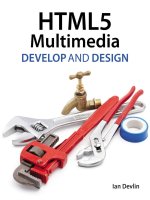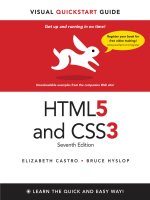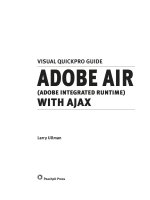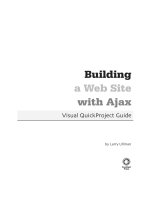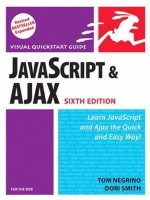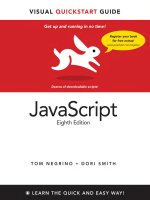peachpit press visual quickstart guide javascript 8th (2012)
Bạn đang xem bản rút gọn của tài liệu. Xem và tải ngay bản đầy đủ của tài liệu tại đây (20.5 MB, 544 trang )
ptg
ptg
Peachpit Press
VISUAL QUICKSTART GUIDE
JavaScript
EIGHTH EDITION
TOM NEGRINO • DORI SMITH
ptg
Visual QuickStart Guide
JavaScript, Eighth Edition
Tom Negrino and Dori Smith
Peachpit Press
1249 Eighth Street
Berkeley, CA 94710
(510) 524-2178
(510) 524-2221 (fax)
Find us on the Web at www.peachpit.com
To report errors, send a note to
Peachpit Press is a division of Pearson Education
Copyright © 2012 by Tom Negrino and Dori Smith
Editor: Nancy Peterson
Production Editor: Tracey Croom
Copyeditor: Scout Festa
Compositor: Danielle Foster
Indexer: Emily Glossbrenner
Cover Design: RHDG / Riezebos Holzbaur Design Group, Peachpit Press
Interior Design: Peachpit Press
Logo Design: MINE™ www.minesf.com
Notice of rights
All rights reserved. No part of this book may be reproduced or transmitted in any form by any means,
electronic, mechanical, photocopying, recording, or otherwise, without the prior written permission of the
publisher. For information on getting permission for reprints and excerpts, contact
Notice of liability
The information in this book is distributed on an “As is” basis, without warranty. While every precaution has
been taken in the preparation of the book, neither the authors nor Peachpit Press, shall have any liability to any
person or entity with respect to any loss or damage caused or alleged to be caused directly or indirectly by the
instructions contained in this book or by the computer software and hardware products described in it.
Trademarks
Visual QuickStart Guide is a registered trademark of Peachpit Press, a division of Pearson Education. Many of
the designations used by manufacturers and sellers to distinguish their products are claimed as trademarks.
Where those designations appear in this book, and Peachpit Press was aware of a trademark claim, the
designations appear as requested by the owner of the trademark. All other product names and services
identified throughout this book are used in editorial fashion only and for the benefit of such companies with no
intention of infringement of the trademark. No such use, or the use of any trade name, isintended to convey
endorsement or other affiliation with this book.
ISBN 13: 978-0-321-77297-8
ISBN 10: 0-321-77297-0
0 9 8 7 6 5 4 3 2 1
Printed in the United States of America
ptg
Dedication
To the memory of Bill Horwitz and Dorothy Negrino, because they
lovedlearning.
ptg
Special Thanks to:
Big thanks to our editor Nancy Peterson; her expert touch, serenity, and
compassion made this edition a pleasant one to create.
Thanks to Tracey Croom for her excellent production work and to Scout
Festa for her skillful copyediting.
Our heartfelt thanks to Danielle Foster, the book’s compositor, who
laidout the book and pulled off the job with grace and aplomb, and to
the indexer, Emily Glossbrenner, who should be thanked for doing a
thankless job.
We’re grateful to Peachpit’s Nancy Ruenzel and Nancy Davis for
theirsupport.
We’d like to express our special thanks to allof the high school, college,
and university instructors who chose to use the previous editions of this
book as a textbook for theirclasses.
Between the time we signed the contract for this book and when we
began working on it, Dori was offered her dream job at Stack Exchange
(
). She could not have worked two jobs
and
still maintained a semblance of sanity without a great deal of help
from others, for which she is truly grateful. In particular:
n
Thanks to all the great folks at Stack: Joel Spolsky, Jeff Atwood,
Robert Cartaino, Rebecca Chernoff, and Josh Heyer, among others—
who gave their time and patience to help me stay employed while
finishing this book.
n
Thanks also to the amazingly patient women at Peachpit—I’ve
worked with you for 14 years, and I’m still in awe of what you’re
ableto create.
n
And in particular, I must thank my co-author, Tom Negrino, who did
much more than his share of the load on this edition, and who post-
poned his (and my) tenth wedding anniversary celebration until the
book was complete.
ptg
Contents at a Glance v
Contents at a Glance
Introduction . . . . . . . . . . . . . . . . . . . . . . . . . xv
Chapter 1 Getting Acquainted with JavaScript . . . . . . . . . .1
Chapter 2 Start Me Up! . . . . . . . . . . . . . . . . . . . . . . . . 21
Chapter 3 Your First Web App . . . . . . . . . . . . . . . . . . . . 49
Chapter 4 Working with Images . . . . . . . . . . . . . . . . . . . 81
Chapter 5 Windows and Frames. . . . . . . . . . . . . . . . . . 115
Chapter 6 Form Handling . . . . . . . . . . . . . . . . . . . . . . 133
Chapter 7 Forms and Regular Expressions . . . . . . . . . . . 171
Chapter 8 Handling Events . . . . . . . . . . . . . . . . . . . . . 195
Chapter 9 JavaScript and Cookies . . . . . . . . . . . . . . . . 219
Chapter 10 Objects and the DOM . . . . . . . . . . . . . . . . . 241
Chapter 11 Making Your Pages Dynamic . . . . . . . . . . . . . 261
Chapter 12 Applied JavaScript . . . . . . . . . . . . . . . . . . . 285
Chapter 13 Introducing Ajax . . . . . . . . . . . . . . . . . . . . . 325
Chapter 14 Toolkits, Frameworks, and Libraries . . . . . . . . 363
Chapter 15 Designing with jQuery . . . . . . . . . . . . . . . . . 377
Chapter 16 Building on jQuery . . . . . . . . . . . . . . . . . . . 397
Chapter 17 Bookmarklets . . . . . . . . . . . . . . . . . . . . . . . 425
Appendix A JavaScript Genealogy and Reference . . . . . . . 453
Appendix B JavaScript Reserved Words . . . . . . . . . . . . . . 477
Appendix C Cascading Style Sheets Reference . . . . . . . . . 481
Appendix D Where to Learn More. . . . . . . . . . . . . . . . . . 489
Index . . . . . . . . . . . . . . . . . . . . . . . . . . . . 497
ptg
This page intentionally left blank
ptg
Table of Contents vii
Table of Contents
Introduction. . . . . . . . . . . . . . . . . . . . . . . . . . xv
Chapter 1 Getting Acquainted with JavaScript . . . . . . . . . . 1
What JavaScript Is . . . . . . . . . . . . . . . . . . . . . . . 2
JavaScript Isn’t Java. . . . . . . . . . . . . . . . . . . . . . 3
Where JavaScript Came From . . . . . . . . . . . . . . . . 5
What JavaScript Can Do . . . . . . . . . . . . . . . . . . . 6
What JavaScript Can’t Do. . . . . . . . . . . . . . . . . . . 7
What Is Ajax?. . . . . . . . . . . . . . . . . . . . . . . . . . 8
The Snap-Together Language . . . . . . . . . . . . . . . . 11
Handling Events . . . . . . . . . . . . . . . . . . . . . . . .14
Values and Variables . . . . . . . . . . . . . . . . . . . . 15
Writing JavaScript-Friendly HTML . . . . . . . . . . . . . .17
What Tools to Use? . . . . . . . . . . . . . . . . . . . . . 20
Chapter 2 Start Me Up! . . . . . . . . . . . . . . . . . . . . . . . . .21
Where to Put Your Scripts . . . . . . . . . . . . . . . . . 23
About Functions . . . . . . . . . . . . . . . . . . . . . . . 25
Using External Scripts. . . . . . . . . . . . . . . . . . . . 26
Putting Comments in Scripts . . . . . . . . . . . . . . . . 29
Alerting the User . . . . . . . . . . . . . . . . . . . . . . 31
Confirming a User’s Choice . . . . . . . . . . . . . . . . 33
Prompting the User . . . . . . . . . . . . . . . . . . . . . 35
Redirecting the User witha Link . . . . . . . . . . . . . . 37
Using JavaScript to Enhance Links . . . . . . . . . . . . 39
Using Multi-Level Conditionals . . . . . . . . . . . . . . 43
Handling Errors . . . . . . . . . . . . . . . . . . . . . . . 46
ptg
viii Table of Contents
Chapter 3 Your First Web App. . . . . . . . . . . . . . . . . . . . .49
Around and Around withLoops . . . . . . . . . . . . . . 50
Passing a Value to a Function . . . . . . . . . . . . . . . 55
Detecting Objects . . . . . . . . . . . . . . . . . . . . . . 57
Working with Arrays. . . . . . . . . . . . . . . . . . . . . 59
Working with Functions That Return Values . . . . . . . 61
Updating Arrays . . . . . . . . . . . . . . . . . . . . . . . 62
Using Do/While Loops . . . . . . . . . . . . . . . . . . . 64
Calling Scripts Multiple Ways . . . . . . . . . . . . . . . 66
Combining JavaScript andCSS . . . . . . . . . . . . . . 68
Checking State. . . . . . . . . . . . . . . . . . . . . . . . 71
Working with String Arrays . . . . . . . . . . . . . . . . . 77
Chapter 4 Working with Images. . . . . . . . . . . . . . . . . . . .81
Creating Rollovers. . . . . . . . . . . . . . . . . . . . . . 83
Creating More Effective Rollovers. . . . . . . . . . . . . 85
Building Three-State Rollovers. . . . . . . . . . . . . . . 91
Triggering Rollovers from a Link . . . . . . . . . . . . . . 93
Making Multiple Links Change a Single Rollover . . . . 96
Working with Multiple Rollovers . . . . . . . . . . . . . . 99
Creating Cycling Banners . . . . . . . . . . . . . . . . .104
Adding Links to Cycling Banners . . . . . . . . . . . . .106
Building Wraparound Slideshows . . . . . . . . . . . . .108
Displaying a Random Image . . . . . . . . . . . . . . . . 111
Cycling Images with a Random Start . . . . . . . . . . . 113
Chapter 5 Windows and Frames . . . . . . . . . . . . . . . . . . 115
Keeping a Page outofaFrame . . . . . . . . . . . . . . 117
Setting a Target . . . . . . . . . . . . . . . . . . . . . . . 118
Loading Iframes with JavaScript . . . . . . . . . . . . . .120
Working with Iframes . . . . . . . . . . . . . . . . . . . . 121
ptg
Table of Contents ix
Creating Dynamic Iframes . . . . . . . . . . . . . . . . . 123
Sharing Functions between Documents . . . . . . . . . 125
Opening a New Window . . . . . . . . . . . . . . . . . . 127
Loading Different Contents into a Window . . . . . . . . 131
Chapter 6 Form Handling . . . . . . . . . . . . . . . . . . . . . . . 133
Select-and-Go Navigation . . . . . . . . . . . . . . . . . 135
Changing Menus Dynamically . . . . . . . . . . . . . . .140
Making Fields Required. . . . . . . . . . . . . . . . . . . 142
Checking Fields against Each Other . . . . . . . . . . . 147
Identifying Problem Fields . . . . . . . . . . . . . . . . . 149
Putting Form Validation into Action . . . . . . . . . . . . 151
Working with Radio Buttons . . . . . . . . . . . . . . . .156
Setting One Field withAnother . . . . . . . . . . . . . .159
Validating Zip Codes . . . . . . . . . . . . . . . . . . . .162
Validating Email Addresses . . . . . . . . . . . . . . . .166
Chapter 7 Forms and Regular Expressions. . . . . . . . . . . . 171
Validating an Email Address with
Regular Expressions . . . . . . . . . . . . . . . . . . . 173
Validating a File Name . . . . . . . . . . . . . . . . . . . 178
Extracting Strings . . . . . . . . . . . . . . . . . . . . . .180
Formatting Strings. . . . . . . . . . . . . . . . . . . . . .183
Formatting and Sorting Strings . . . . . . . . . . . . . . 187
Formatting and Validating Strings . . . . . . . . . . . . .189
Replacing Elements using Regular Expressions . . . . .192
Chapter 8 Handling Events . . . . . . . . . . . . . . . . . . . . . . 195
Handling Window Events. . . . . . . . . . . . . . . . . .196
Mouse Event Handling . . . . . . . . . . . . . . . . . . 204
Form Event Handling . . . . . . . . . . . . . . . . . . . .212
Key Event Handling . . . . . . . . . . . . . . . . . . . . .216
ptg
x Table of Contents
Chapter 9 JavaScript and Cookies . . . . . . . . . . . . . . . . . 219
Baking Your First Cookie . . . . . . . . . . . . . . . . . 221
Reading a Cookie . . . . . . . . . . . . . . . . . . . . . 225
Showing Your Cookies . . . . . . . . . . . . . . . . . . 226
Using Cookies as Counters . . . . . . . . . . . . . . . 228
Deleting Cookies . . . . . . . . . . . . . . . . . . . . . 231
Handling Multiple Cookies . . . . . . . . . . . . . . . . 233
Displaying “New to You” Messages . . . . . . . . . . . 235
Chapter 10 Objects and the DOM . . . . . . . . . . . . . . . . . . 241
About Node Manipulation . . . . . . . . . . . . . . . . 242
Adding Nodes . . . . . . . . . . . . . . . . . . . . . . . 244
Deleting Nodes . . . . . . . . . . . . . . . . . . . . . . 246
Deleting Specific Nodes . . . . . . . . . . . . . . . . . 248
Inserting Nodes . . . . . . . . . . . . . . . . . . . . . . 251
Replacing Nodes . . . . . . . . . . . . . . . . . . . . . 254
Writing Code with ObjectLiterals . . . . . . . . . . . . 257
Chapter 11 Making Your Pages Dynamic. . . . . . . . . . . . . . 261
Putting the Current Date into a Web Page . . . . . . . 262
Working with Days. . . . . . . . . . . . . . . . . . . . . 264
Customizing a Message for the Time of Day . . . . . . 265
Displaying Dates by TimeZone . . . . . . . . . . . . . 266
Converting 24-Hour Time to 12-Hour Time . . . . . . . 272
Creating a Countdown . . . . . . . . . . . . . . . . . . 274
Hiding and Displaying Layers . . . . . . . . . . . . . . 278
Moving an Object in the Document . . . . . . . . . . . 281
Date Methods . . . . . . . . . . . . . . . . . . . . . . . 283
ptg
Table of Contents xi
Chapter 12 Applied JavaScript . . . . . . . . . . . . . . . . . . . . 285
Using Sliding Menus . . . . . . . . . . . . . . . . . . . 286
Adding Pull-Down Menus. . . . . . . . . . . . . . . . . 289
Enhancing Pull-Down Menus. . . . . . . . . . . . . . . 293
A Slideshow with Captions . . . . . . . . . . . . . . . . 297
A Silly Name Generator . . . . . . . . . . . . . . . . . . 301
A Bar Graph Generator . . . . . . . . . . . . . . . . . . 306
Style Sheet Switcher . . . . . . . . . . . . . . . . . . . 315
Chapter 13 Introducing Ajax. . . . . . . . . . . . . . . . . . . . . . 325
Ajax: Pinning It Down . . . . . . . . . . . . . . . . . . . 327
Reading Server Data . . . . . . . . . . . . . . . . . . . 331
Parsing Server Data . . . . . . . . . . . . . . . . . . . . 339
Refreshing Server Data . . . . . . . . . . . . . . . . . . 346
Getting Data From a Server . . . . . . . . . . . . . . . 349
Previewing Links with Ajax . . . . . . . . . . . . . . . . 353
Auto-Completing Form Fields . . . . . . . . . . . . . . 357
Chapter 14 Toolkits, Frameworks, and Libraries . . . . . . . . . 363
Adding jQuery . . . . . . . . . . . . . . . . . . . . . . . 365
Updating a Page with jQuery . . . . . . . . . . . . . . 368
Interacting with jQuery . . . . . . . . . . . . . . . . . . 369
Interacting and Updating . . . . . . . . . . . . . . . . . 371
Auto-Completing Fields . . . . . . . . . . . . . . . . . 374
Chapter 15 Designing with jQuery . . . . . . . . . . . . . . . . . . 377
Highlighting New Elements . . . . . . . . . . . . . . . 378
Creating Accordion Menus . . . . . . . . . . . . . . . . 382
Creating Smarter Dialogs. . . . . . . . . . . . . . . . . 386
Striping Tables . . . . . . . . . . . . . . . . . . . . . . . 390
Sorting Tables . . . . . . . . . . . . . . . . . . . . . . . 393
ptg
xii Table of Contents
Chapter 16 Building on jQuery . . . . . . . . . . . . . . . . . . . . 397
Using jQuery as a Foundation . . . . . . . . . . . . . . 398
Using ThemeRoller to Customize Your Look . . . . . . 400
Adding a Calendar to Your Page. . . . . . . . . . . . . 403
Dragging and Dropping Elements. . . . . . . . . . . . 408
Using jQuery with External Data. . . . . . . . . . . . . . 411
Using jQuery Plugins . . . . . . . . . . . . . . . . . . . 420
Chapter 17 Bookmarklets. . . . . . . . . . . . . . . . . . . . . . . . 425
Your First Bookmarklet . . . . . . . . . . . . . . . . . . 426
Resetting a Web Page’s Background . . . . . . . . . . 432
Changing a Page’s Styles. . . . . . . . . . . . . . . . . 433
Word Lookups . . . . . . . . . . . . . . . . . . . . . . . 436
Viewing Images . . . . . . . . . . . . . . . . . . . . . . 439
Displaying ISO Latin Characters . . . . . . . . . . . . . 441
Converting RGB Values toHex . . . . . . . . . . . . . 444
Converting Values. . . . . . . . . . . . . . . . . . . . . 446
A Bookmarklet Calculator . . . . . . . . . . . . . . . . 447
Shortening URLs. . . . . . . . . . . . . . . . . . . . . . 449
Validating Pages. . . . . . . . . . . . . . . . . . . . . . 450
Mailing Pages . . . . . . . . . . . . . . . . . . . . . . . 451
Resizing Pages. . . . . . . . . . . . . . . . . . . . . . . 452
Appendix A JavaScript Genealogy and Reference . . . . . . . . 453
JavaScript Versions . . . . . . . . . . . . . . . . . . . . 454
ECMAScript . . . . . . . . . . . . . . . . . . . . . . . . 457
Object Flowchart . . . . . . . . . . . . . . . . . . . . . 459
The Big Object Table . . . . . . . . . . . . . . . . . . . 465
ptg
Table of Contents xiii
Appendix B JavaScript Reserved Words . . . . . . . . . . . . . . 477
Appendix C Cascading Style Sheets Reference . . . . . . . . . . 481
Appendix D Where to Learn More . . . . . . . . . . . . . . . . . . 489
Finding Help Online . . . . . . . . . . . . . . . . . . . . 490
Offline Resources . . . . . . . . . . . . . . . . . . . . . 493
Troubleshooting Tips . . . . . . . . . . . . . . . . . . . 494
Index . . . . . . . . . . . . . . . . . . . . . . . . . . . . . 497
ptg
This page intentionally left blank
ptg
Introduction xv
Welcome to JavaScript! Using this easy-
to-learn programming language, you’ll be
able to add pizzazz to your Web pages and
make them more useful for you and for your
site’s visitors. We’ve written this book as a
painless introduction to JavaScript, so you
don’t have to be a geek or a nerd to write a
script. Pocket protectors will not be neces-
sary at any time. As a friend of ours says,
“We’re geeky, so you don’t have to be!”
We wrote this
book for you
We figure that if you’re interested in
JavaScript, then you’ve already got some
experience in creating HTML pages and
Web sites, and you want to take the next
step by adding some interactivity to your
sites. We don’t assume that you know
anything about programming or scripting.
We also don’t assume that you are an HTML
expert (though if you are, that’s just fine).
We do assume that you’ve got at least the
basics of building Web pages down, and
Introduction
that you have some familiarity with common
HTML, such as links, images, and forms.
We include some extra explanation of HTML
in sidebars called “Just Enough HTML.” You
won’t find these sidebars in every chapter,
just the ones where we think you’ll need
a quick reference. Having this informa-
tion handy means you won’t need multiple
books or Web pages open just to remember
the syntax of a particular HTML attribute.
If you already know something about pro-
gramming, you should be aware that we
don’t take the same approach to JavaScript
as you might have seen in other books. We
don’t delve deeply into JavaScript’s syntax
and structure, and we don’t pretend that
this book is a comprehensive language
reference (though you’ll find some valuable
reference material in Appendix A, the color
section in the back of the book). There are
several other books on the market that
do that job admirably, and we list them
at the end of this book, in Appendix D.
The difference between those books and
this one is that instead of getting bogged
down in formalism, we concentrate on
ptg
xvi Introduction
showing you how to get useful tasks done
with JavaScript without a lot of extraneous
information.
In previous editions, we added an intro-
duction to Ajax, a technique that uses
JavaScript and other common Web tech-
nologies to add extra interactivity to Web
pages, and to improve the user experi-
ence of your Web sites. We covered the
basics of Ajax and added some practical
examples to allow you to Ajax-ify your
sites without getting an advanced degree
in Web programming. In this edition,
we’ve added even more examples and
techniques, using the jQuery
framework
—
which you can think of as building blocks
that allow you to easily add useful features
to your sites.
ptg
Introduction xvii
How to use this book
Throughout the book, we’ve used some
devices that should make it easier for
youto work both with the book and with
JavaScript itself.
In the step-by-step instructions that
makeup most of the book, we’ve used a
special type style to denote either HTML
orJavaScript code, like this:
<div id="thisDiv">
➝
window.onload = initLinks;
You’ll also notice that we show the HTML
and the JavaScript in lowercase. We’ve
done that because all of the scripts in this
edition are compliant with the in-progress
HTML5 standard from the W3C, the World
Wide Web Consortium. Whenever you see
a quote mark in a JavaScript, it is always
a straight quote (like
'
or
"
), never curly
quotes (aka “smart” quotes, like ’ or “).
Curly quotes will prevent your JavaScript
from working, so make sure that you avoid
them when you write scripts.
In the illustrations accompanying the step-
by-step instructions, we’ve highlighted the
part of the scripts that we’re discussing in
red
, so you can quickly find what we’re
talking about. We often also highlight parts
of thescreen shots of Web browser win-
dows in
red
, to indicate the most important
part ofthe picture.
Because book pages are narrower than
computer screens, some of the lines of
JavaScript code are too long to fit on the
page. When this happens, we’ve broken the
line of code up into one or more segments,
inserted this gray arrow ➝ to indicate that
it’s a continued line, and indented the rest of
the line. Here’s an example of how we show
long lines in scripts.
dtString = "Hey, just what are you
➝
doing up so late?";
ptg
xviii Introduction
You say browser,
we say Kumbaya
Beginning with the Sixth edition of this
book, we made a big change: we ended our
support for browsers that are very old or
that don’t do a good job of supporting Web
standards. We’d found that virtually all Web
users have upgraded and are enjoying the
benefits of modern browsers, ones that do a
good-to-excellent job of supporting com-
monly accepted Web standards like HTML,
CSS2, and the Document Object Model.
That covers Internet Explorer 7 or later;
Firefox 1.0 or later; all versions of Safari and
Chrome; and Opera 7 or later.
We’ve tested our scripts in a wide variety
of browsers, on several different operating
systems, including Windows (both Vista and
Windows 7; like Microsoft, we’ve dropped
support for Windows XP), Mac OS X (10.4.11
and later), and Ubuntu Linux (we only tested
scripts in Firefox, Ubuntu’s default browser).
We used the 600-pound gorilla of the
browser world, Microsoft Internet Explorer
for Windows, to test virtually everything in
the book (we used versions 7, 8, and 9). We
also tested the scripts with Firefox 3 and 4,
for Mac and Windows, and with Safari5 for
Mac and Windows. Working with the latter
browser means that our scripts should
also work in any browsers based on the
WebKit engine (including Google Chrome),
and on browsers (such as Konqueror for
Linux) based on KHTML, the open-source
rendering engine from which Safari got its
start. WebKit is also the basis for browsers
in mobile operating systems, such as
Apple’s iOS, Google’s Android, Research
inMotion’s Blackberry 6 and later, and HP’s
WebOS. So far as mobile devices go, we
mainly tested scripts on iPhones and iPads.
ptg
Introduction xix
Don’t type that code!
Some JavaScript books print the scripts
and expect you to type in the examples.
We think that’s way too retro for this day
and age. It was tough enough for us to
doall that typing, and there’s no reason
you should have to repeat that work.
Sowe’ve prepared a companion Web
sitefor this book, one that includes all of
the scripts in the book, ready for you to
justcopy and paste into your own Web
pages. The site also includes additional
tips and scripts. If we discover any mis-
takes in the book that got through the
editing process, we’ll list the updates on
the site, too. You can find our companion
site at
www.javascriptworld.com
.
If for some reason you do plan to type in
some script examples, you might find that
the examples don’t seem to work, because
you don’t have the supporting files that we
used to create the examples. For example,
in a task where an on-screen effect hap-
pens to an image, you’ll need image files.
No problem. We’ve put all of those files up
on the book’s Web site, nicely packaged
for you to download. You’ll find one down-
loadable file that contains all of the scripts,
HTML files, CSS files, and any media files
we used. If you have any questions, please
check the FAQ (Frequently Asked Ques-
tions) page on the companion Web site.
It’sclearly marked.
If you’ve read the FAQ and your question
isn’tanswered there, you can contact us
viaemail at:
.
Weregret that because of the large vol-
ume of email that we get, we cannot, and
will not,answer email about the book sent
to our personal email addresses. We can
only guarantee that messages sent to the
address will
beanswered.
ptg
xx Introduction
Time to get started
One of the best things about JavaScript is
that it’s easy to start with a simple script
that makes cool things happen on your
Web page, then add more complicated
stuff as you need it. You don’t have to learn
a whole book’s worth of information before
you can start improving your Web pages.
But by the time you’re done with the book,
you’ll be adding advanced interactivity to
your sites with Ajax and jQuery.
Of course, every journey begins with the
first step, and if you’ve read this far, your
journey into JavaScript has already begun.
Thanks for joining us; please keep your
hands and feet inside the moving vehicle.
And please, no flash photography.
ptg
For Web site creators, the evolution of
HTML has been a mixed blessing. In the
early days of the World Wide Web, HTML
was fairly simple, and it was easy to learn
everything you needed to put together
Web pages.
As the Web grew, page designers wanted
their pages to interact with users, and
it soon became obvious that HTML
was insufficient to handle the demand.
Netscape invented JavaScript as a way
tocontrol the browser and add pizzazz
andinteractivity to Web pages.
Since its creation, JavaScript has evolved
quite a bit (although occasionally in different
directions, depending on the browser). Later,
we’ll discuss JavaScript’s evolution in detail.
In this chapter, you’ll learn what JavaScript
is (and what it isn’t); what it can do (and
what it can’t); some of the basics of the
JavaScript language; and you’ll get an
introduction to Ajax, the combination of
JavaScript with other technologies that has
enabled a wave of interactivity and creativ-
ity for Web sites.
1
Getting Acquainted
with JavaScript
In This Chapter
What JavaScript Is 2
JavaScript Isn’t Java 3
Where JavaScript Came From 5
What JavaScript Can Do 6
What JavaScript Can’t Do 7
What Is Ajax? 8
The Snap-Together Language 11
Handling Events 14
Values and Variables 15
Writing JavaScript-Friendly HTML 17
What Tools to Use? 20
ptg
2 Chapter 1
What JavaScript Is
JavaScript is a programming language
thatyou can use to add interactivity
to yourWeb pages. But if you’re not a
programmer, don’t panic; there are lots of
JavaScripts available on the Web that you
can copy and modify for your own use with
a minimum of effort. In fact, standing on the
shoulders of other programmers in this way
is a great technique for getting comfortable
with JavaScript.
To make it easier for you to get up and
running with JavaScript, we have set up
a Web site that supplements this book.
We’veincluded all the scripts in the book
(so you don’t have to type them in your-
self!), as well as additional notes, addenda,
andupdates. You can find our site at
www.javascriptworld.com
.
You’ll often see JavaScript referred to as a
“scripting language,” with the implication
that it is somehow easier to script than to
program. It’s a distinction without a differ-
ence, in this case. A JavaScript script is a
program that either is contained internally
in an HTML page (the original method of
scripting) or resides in an external file (the
now-preferred method). On HTML pages,
because it is enclosed in the
<script>
tag,
the text of the script doesn’t appear on
the user’s screen, and the Web browser
knows to run the JavaScript. The
<script>
tag is most often found within the
<head>
section of the HTML page, as in Listing 1.1,
though you can, if you wish, have scripts in
the
<body>
section. If you’re unfamiliar with
these HTML concepts and you need more
information about HTML, we suggest that
you check out Elizabeth Castro’s
HTML,
XHTML, and CSS: Visual QuickStart
Guide
,
Sixth Edition,
also available from
Peachpit Press.
Listing 1.1 This very simple script types “Hello,
Cleveland!” into the browser window.
<!DOCTYPE html>
<html>
<head>
<title>Barely a script at all</title>
<script>
window.onload = function() {
document.getElementById
➝
("myMessage").innerHTML =
➝
"Hello, Cleveland!";
}
</script>
</head>
<body>
<h1 id="myMessage">
</h1>
</body>
</html>
ptg
Getting Acquainted with JavaScript 3
JavaScript Isn’t Java
Despite the names, JavaScript and
Java have almost nothing to do with
one another. Java is a full-featured pro-
gramming language developed by Sun
Microsystems and marketed by Oracle
(since their purchase of Sun). With Java,
a descendant of the C and C++ program-
ming languages, programmers can create
entire applications and control consumer
electronic devices. Unlike other languages,
Java promises cross-platform compatibil-
ity; that is, a programmer should be able
to write one Javaprogram that can then
run on any kindof machine, whether that
machine is running Windows, MacOSX,
or any of the different flavors of Unix. In
practice, Java hasn’t always realized that
dream, due in no small part to bickering
between Sun and Microsoft as to the
direction of the language. Microsoft got
involved because it first wanted to inte-
grate Java into Windows in its own way (a
way that Sun said would make Java work
one way on Windows, and another way on
other machines, thereby defeating Java’s
main purpose); then Microsoft dropped
Sun’s Javafrom Windows altogether, after
creating its own Java-like language, C#.
After aflurry of lawsuits between the two
companies (and a big settlement in favor
ofSun), Microsoft removed its Java from
Windows, and you cannow install the lat-
est version ofJavafor Windows (or Linux)
at
www.java.com/getjava/
. MacOSX
comes with Java installed as part of the
operating system.
ptg
4 Chapter 1
Besides standalone applications, Java’s
main use on the
client side
, that is, in
the user’s browser, is to create
applets
,
small programs that download over the
Internet and run inside Web browsers.
Because of Java’s cross-platform nature,
these applets should run identically on
any Java-enabled browser. In recent
years, we’ve seen many Java applets for
browsers replaced by Adobe Flash anima-
tions, which are generally easier to create
than Java applets. In recent years, the
increase of computer processing speeds
and improved JavaScript implementations
in browsers have further eroded Java’s
use on the client side. However, Java has
become a popular language for applica-
tions written for use on the server side.
You embed Java applets in your Web pages
using the
<object>
HTML tag, with addi-
tional information specifying the applet.
When the browser sees the
<object>
tag,
itdownloads the Java applet from the
server, and the applet then runs in the area
of the screen specified in the tag
A
.
A
This Java applet plays a mean game of
checkers.


